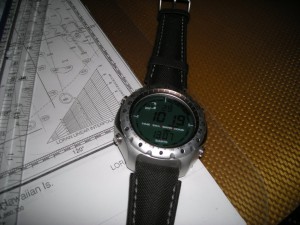July 19th, 19:45 utc – lat 25 32 N, lon 129 35 W
We are in the trades. Our two on-board barometers show us around the 1019 isobar and that is exactly where we want to be. Those two barometers are a Vetus recording barometer and the Suunto watch that I wear on the wrist. They are carefully calibrated and together give us an objective assessment of the weather forecasting models, gribs and other modern tools. Guess what: there is no single weather model that has been matching our barometers. In fact, according to all the models, we should now be sailing in 5 knots of breeze. I cross my fingers, but I can see that we are sailing with a wind direction of 25 degrees (North Easterly) at 15 knots around the 1019 isobar on a favorable heading to Hawaii. All good things.
It is now a tough job at keeping everything going on the boat with just the two of us. I mean everything. On a fully crewed boat you have trimmers, bowmen, navigators, helmsmen, cooks. The two of us split all of these responsibilities. Richard does the trimming, the bow and the cooking. We split the driving and I do the navigation and the blog. We’re a great team. No job too big, no job too small. When we have to, we both pick up anything. When we do sail changes, it’s full on. In the last 6 hours we went through 2 spinnakers and staysails. We now have our big gear up – the A2 with the bigger spinnaker staysail. We’re surfing our way to Hawaii. Just like they said in the brochure.
Navigators and Innovators
Navigating this complicated weather pattern is much akin to navigating the future of technology and science. There can be no long term success without clear vision, knowledge and know-how, intuition and some luck.
Before the age of GPS, as navigators, we spent a large portion of our time figuring out where we are. Many think that now navigators can focus on figuring out where they are going as opposed to where they are. I disagree. That’s because the process of working out where you are gives you many clues as to where to go next. You look at the sky, measure angles, look at the clouds, the ocean, look for horizons and you take it all in. You literally tune yourself to the environment. Navigating without mastering the craft of navigation is like driving at night without lights. There is a long tradition of navigation that dates back thousands of years with the Polynesian people. It is well and alive today.
For innovation to happen first you must know where you are and then know where your going. You have to be a navigator. Progress is driven by navigators and explorers.
